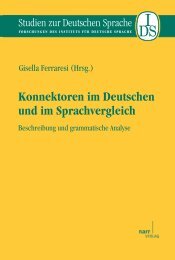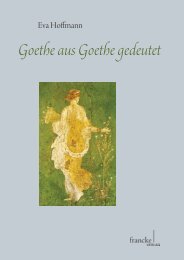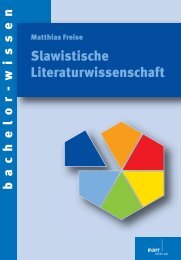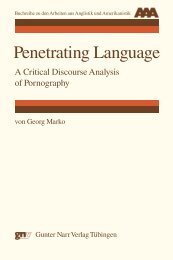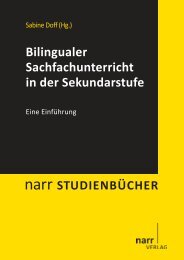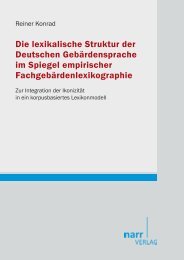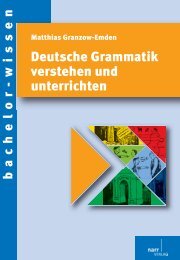Phraseologie. global - areal - regional - im Shop von Narr Francke ...
Phraseologie. global - areal - regional - im Shop von Narr Francke ...
Phraseologie. global - areal - regional - im Shop von Narr Francke ...
You also want an ePaper? Increase the reach of your titles
YUMPU automatically turns print PDFs into web optimized ePapers that Google loves.
Elisabeth Piirainen (Steinfurt)<br />
Common features in the phraseology of European<br />
languages: Cultural and <strong>areal</strong> perspectives<br />
1 Introduction to the problems<br />
The linguistic discipline of phraseological research looks back at a more than one hundred year<br />
old tradition. The studies on phraseology carried out by Charles Bally (1905; 1909), especially his<br />
influential classification of fixed expressions in the context of his “stylistique”, are usually regarded<br />
as the beginning of modern linguistic research into phraseology. Indeed it was Charles<br />
Bally who pointed out extensive cross-linguistic s<strong>im</strong>ilarities between the languages of Europe that<br />
were even more striking than their differences – a fact he tried to link to a “European mentality”:<br />
Même pour un observateur superficiel, les langues modernes des pays dits « civilisés » offrent des ressemblances<br />
en nombre incalculable, et dans leur incessante évolution, ces langues, loin de se différencier,<br />
tendent à se rapprocher toujours davantage. La cause de ces rapprochements n’est pas difficile à<br />
trouver; elle réside dans les échanges multiples qui se produisent de peuple à peuple, dans le monde matériel<br />
et dans le domaine de la pensée. […] Appelons ce fonds commun, faute de mieux, la mentalité européenne.<br />
(Bally 1909, 22f.)<br />
Whether Bally also had phraseology in mind here, and which modern languages exactly he was<br />
referring to, is not explicitly clear from his remarks. It should be noted, however, how even more<br />
than one hundred years ago there was an awareness of the far-reaching s<strong>im</strong>ilarities between the<br />
languages of Europe. Still to this day, and despite the vast amount of work on idioms, almost<br />
nothing is known about the actual s<strong>im</strong>ilarities that exist between idioms in the European languages.<br />
1 Neither the numerous studies on idioms of various individual languages nor the equally<br />
comprehensive work on contrastive comparisons of the idioms of two or more languages have so<br />
far been able to change this. They have not been able to name the actual idioms that have equivalents<br />
in many European languages and thus describe what idioms can be counted among the “core<br />
inventory” of a common European phraseology.<br />
Further questions that remain unanswered until today include: Which languages take part in<br />
the phraseological correspondences? Are there <strong>areal</strong> centers within Europe? Can differences be<br />
detected between the literary languages und the less established minor languages of Europe? Of<br />
particular interest would be, ult<strong>im</strong>ately, the causes of those s<strong>im</strong>ilarities, i. e. the historical, geographical,<br />
social and cultural factors that are responsible for the dissemination of certain idioms in<br />
many languages inside and outside of Europe.<br />
Solutions to this type of problems cannot be hoped to be tackled by individual people, but only<br />
through collaboration of a large group of researchers and by bundling research initiatives within a<br />
long-term perspective. The fact is, however, that phraseological research even today is more likely<br />
to be undertaken by individuals than in larger teams. At the same t<strong>im</strong>e, researchers often work<br />
on the same problems, even on almost identical phraseological material, without mutual awareness<br />
of their colleagues’ work. Furthermore, researchers tend to group Europe into small units of<br />
1 Unlike idiom research, proverb studies were practised on a multilanguage scale from the beginning, cf. Paczolay’s<br />
(1997) studies on the European proverbs. There is no tradition of Europe-wide idiom studies that would be comparable<br />
to the prosperous international cooperation in the field of proverb research, a gap that was not even recognised until<br />
recently.





